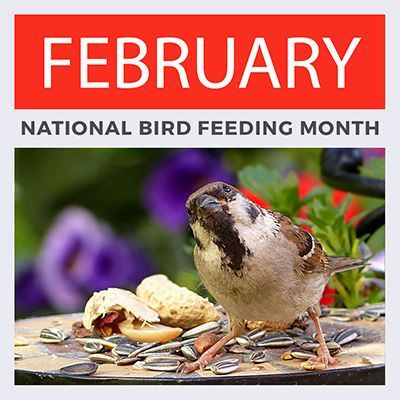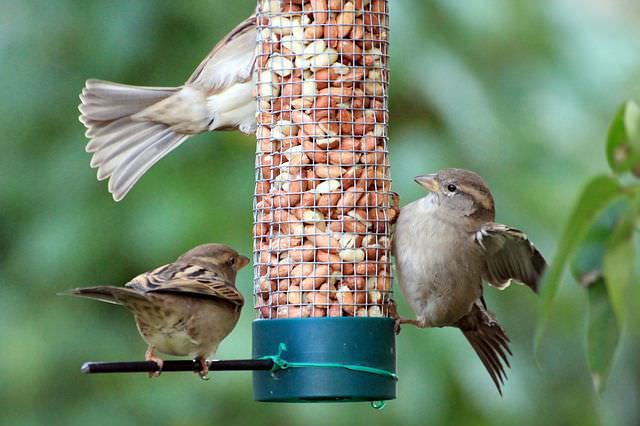It's For the Birds...
February is National Bird Feeding Month, and February, in many parts of the country, is when our feathered friends could use the help. Of course, there is controversy about whether they do need our help, but since the Human Society says it doesn’t hurt, I like to keep my neighborhood birds fat and happy.
 I confess I might be “one of those people” (my husband’s ultimate insult for anyone he thinks is weird) who stands at the kitchen window and is thrilled to see a pileated woodpecker feasting on suet or a goldfinch enjoying some thistle seed. I have the handy binoculars to prove it.
I confess I might be “one of those people” (my husband’s ultimate insult for anyone he thinks is weird) who stands at the kitchen window and is thrilled to see a pileated woodpecker feasting on suet or a goldfinch enjoying some thistle seed. I have the handy binoculars to prove it.
It really isn’t necessary to feed birds year round; the Humane Society recommends those times when birds will be expending the most energy – when they are migrating; when it is very cold; in early spring or late winter when it is difficult to find seeds. You can take the summer off.
There are a couple of exceptions to this rule – hummingbirds expend so much energy that they will benefit from a nectar feeder in the summer; goldfinches can use some thistle seed since thistles go to seed later in the season.
Place your birdfeeders about 12 feet from any bushes, evergreen trees or brush piles; this give the birds somewhere to go if they are being preyed upon but it is far enough away from the feeders that predators can’t just jump out and make a meal of the birds. If you are using ground level feeders, put some chicken wire around them for further protection.
One possible issue you might have is an occasional kamikaze bird who flies into your windows; a way to prevent this is to put feeders at least 30’ away from the house or closer than 3’ to the house; 30’ away keeps them from being confused by reflections; 3’ or closer and the bird can’t get enough momentum to do permanent damage.
What should you serve at your bird buffet?
FALL AND WINTER FARE:
I know from personal experience birds looovvveeee black oil sunflower seeds. These are high in fat and are thin-shelled enough for tiny birds to crack open. If you live near a Tractor Supply or a feed store, you can buy these seeds at a discount.
Birds (and squirrels!) also love peanuts; if you like blue jays, offer up some peanuts. There are specially designed feeders to hold peanuts; personally I like a tray feeder that I can just dump the seeds into. A glob of peanut butter will also go over well.
Suet cakes will attract all kinds of birds (even pileated woodpeckers – you know, Woody Woodpecker). Use the wire cages designed to hold the cakes, however or nighttime stalkers like raccoons will carry them off.
Nyjer (thistle) seeds are good for attracting finches; they are best in close meshed feeders or socks. This keeps them from all blowing away; the thistle seeds are very fine.
Corn – dried; either cracked or on the cob.
The Human Society also suggests white proso millet – something I have no experience with; it is high in protein.

SPRING FARE:
Add fruit, baked and crushed eggshells and nesting materials (human hair, pet fur, bits of string or yarn, small strips of cloth) to the feast.
SUMMER FARE:
Limit feeding to nectar feeders for hummingbirds; you can buy commercial nectar or nectar mixes and nyjer seeds for goldfinches.
According to the Human Society, DO NOT FEED birds fresh or stale bread which has no nutritional value; although I know a gang of sparrows who would disagree with that. Chocolate is toxic to birds (and other animals – God intended it for consumption by hormonal women only). Also leave out the table scraps; you are more likely to attract mice and rats than birds.
How to place the feeders – I have noticed that most of the backyard birds at my house will avail themselves of food no matter how high or low it is; however, if you are trying to attract a particular kind of bird, the Human Society has these suggestions:
Ground level feeders will attract mourning doves, sparrows, juncos and towheesTable level feeders will attract cardinals, finches and jays.
Hanging feeders will attract titmice, goldfinches and chickadees.
Birdfeeders on tree trunks will attract woodpeckers, nuthatches and wrens.
What should I buy?
I have had pretty birdfeeders and functional ones; the functional ones always win out in the end. Plastic, steel and glass are easier to clean than wood or clay feeders. Smaller feeders empty faster but also prevent seeds from sprouting or mildewing. Make sure the feeder has drainage and a cover to keep the seed as dry as possible.
Join the Discussion:
Comments
No posts found
